- What is a merit increase?
- Why does effective use of merit increases rely on strong structural Rewards foundations?
- So it keeps coming back to the need for strong compensation structures before introducing merit increases
- How do you implement those strong compensation foundations? Lessons learnt from the early days of Deliveroo
This expert viewpoint article was written by Rob Green, Founder of Darwin Total Rewards, and an Associate in the MCR Consulting group.
When I speak to companies about how they recognise and reward employee contributions, one key question which comes up is how to use merit increases to reward performance during merit cycles.
This shines through in Ravio’s data too: a recent survey of People and Reward leaders found that 79% of companies are adjusting salaries based on performance in some way at their next compensation review – 41% based on performance only, and 38% performance and inflation (cost of labour or cost of living).
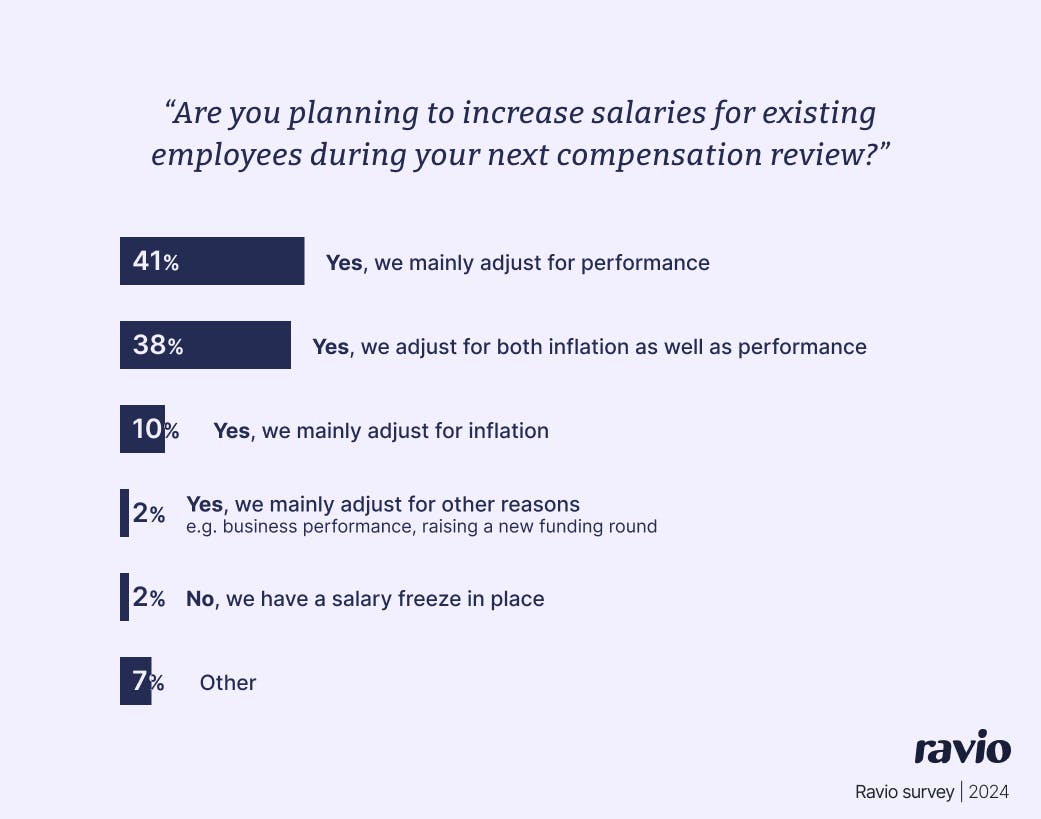
Merit increases can work extremely well as a way to reward your highest-performing employees (as part of a pay for performance model), as well as to give a financial incentive which motivates all employees to work smarter and harder towards business goals – all of which can be great for employee retention and lengthening tenure.
However, when merit increases are implemented incorrectly (and/or at the wrong time in a company’s journey), they can create pay inequities, perceptions of unfair decision-making, company culture issues, and employee disengagement.
In my experience, the success of merit increases comes down to company maturity.
A ‘mature company’ typically refers to a larger, more established company, with a higher headcount and number of office locations.
But really what matters for our merit increase purposes is the size and experience of the People Team, line manager capability, the existing compensation framework, and the performance management and talent processes they currently have in place.
If a company already has: a job architecture, levelling framework, career progression framework, a well-defined set of salary bands based on reliable benchmarking data (including equity/bonus bands if applicable), a strong benefits programme, and an executive compensation strategy, then I’d class it as having a ‘mature’ compensation approach.
On top of this, each of these elements, and the approach to merit increases, must also be clearly and transparently communicated to employees – it’s a holistic, structured approach which has likely been in place for a number of years.
It’s these foundational Rewards structures that ensure that merit increases can be effective.
Subscribe to our newsletter for a monthly treasure trove of insights from Ravio's compensation dataset and network of Rewards experts, to help you navigate a career in compensation 📩
What is a merit increase?
A merit increase is a salary adjustment awarded to employees based on their individual performance, typically as part of an annual pay review process.
Unlike across-the-board cost-of-living or inflation adjustments (which apply to all employees equally), promotions (which involve a change in role level or responsibilities) or market-based pay adjustments (which address external pay competitiveness regardless of performance) merit increases are selective rewards designed to recognise and retain high-performing talent as part of a pay for performance model.
Merit increases are usually expressed as a percentage of an employee's current base salary – for example, a 5% merit increase on a £50,000 salary would result in a new annual salary of £52,500.
The size of the merit increase reflects the employee's performance rating – but many companies also factor in the employee's current compa ratio or range penetration within their salary band, to maintain pay equity. This is typically done using a merit matrix.
Why does effective use of merit increases rely on strong structural Rewards foundations?
In my opinion, the holy grail to build towards is to make merit increases based on a combination of three things:
- Performance ratings
- 9 box grid
- Compa ratio analysis.
Getting this right requires those strong Rewards foundations to already be in place.
The 9 box grid is the ‘cherry on top’ in performance ratings, because it brings current performance together with potential, which makes it much easier to reach consensus across key stakeholders on the top-performing employees and gives leadership the insights they need on career growth, succession planning, and human capital – crucial for meeting (and exceeding!) business objectives.
But employees can’t be fairly placed in the 9 box grid without clear (and well-communicated) performance expectations, a continuous feedback culture that provides evidence, and a compensation philosophy that informs the company’s approach to pay for performance.
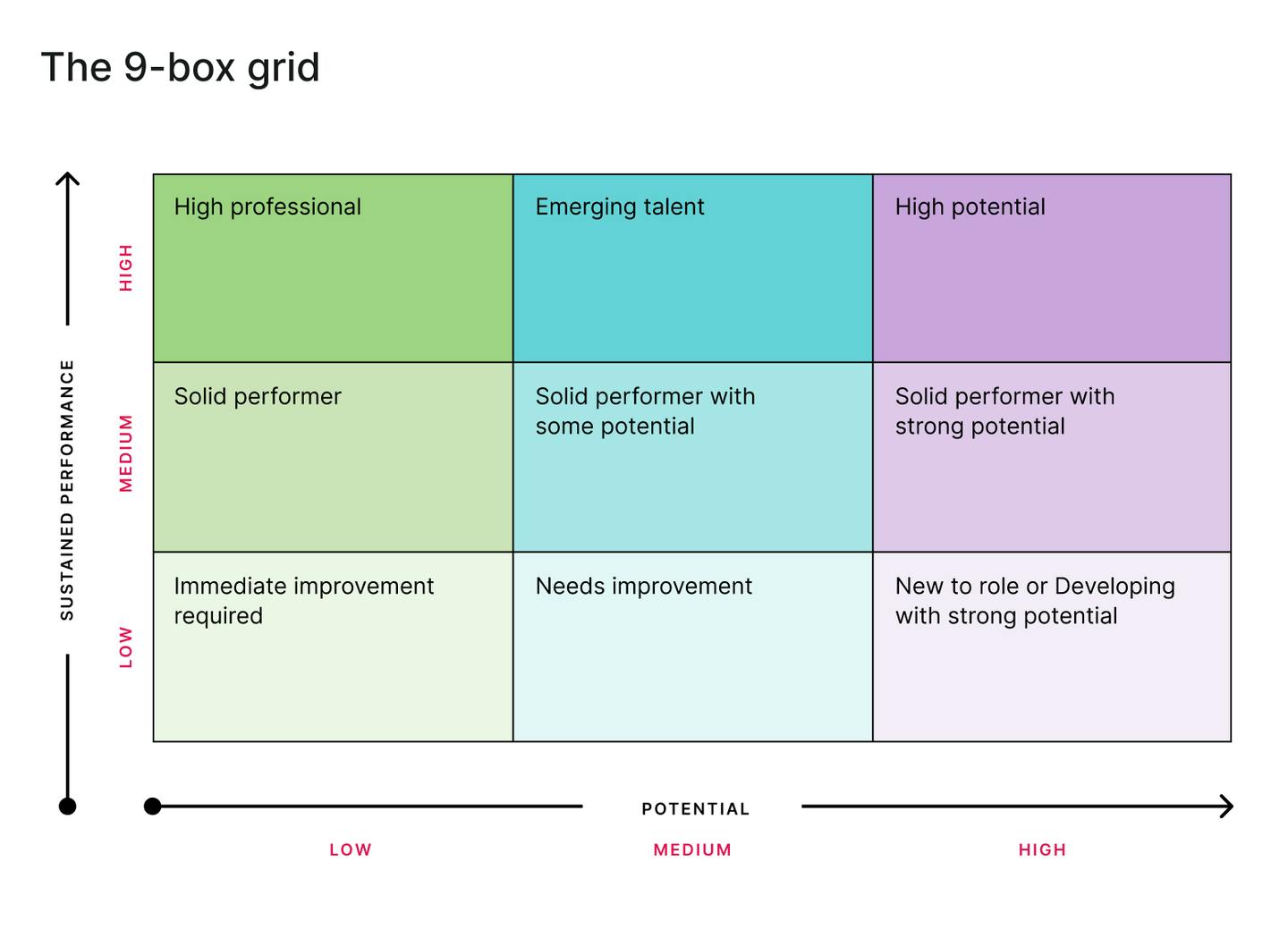
Layering the compa ratio on top of the performance and potential ratings in the 9 box grid is important to inform the size of merit increase that each employee should receive within the merit pool budget – in a similar way to a merit matrix.
If an employee is already at the top end of their salary band then they should (in theory) receive a lower merit increase than an employee who is at the lower end of their salary band to minimise pay equity issues.
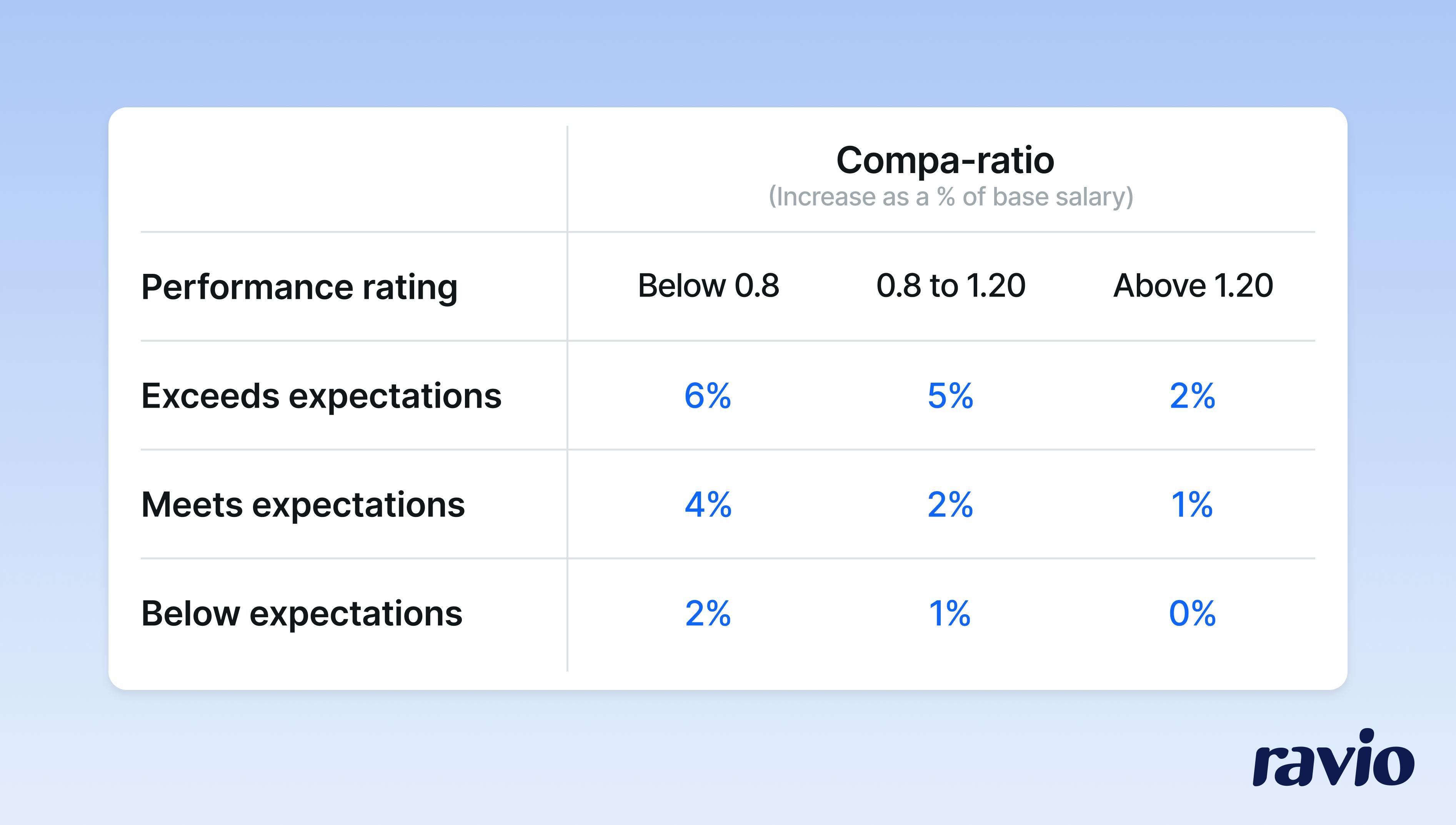
I say ‘in theory’ because manager discretion should also be part of the final decision making process for merit increases – which means strong manager education and training must be in place too.
This is the ‘art’ side of the art and science of compensation, and it’s an important factor. Managers have context that Reward teams don’t, and retaining that discretionary element enables ownership over the process and how it is communicated with employees. Of course, that discretion should always be guided by the People Team to support line managers with the decisions and with managing the budget available.
The compa ratio analysis also enables the merit increase discussion to include the management of salary compression or salary band outliers.
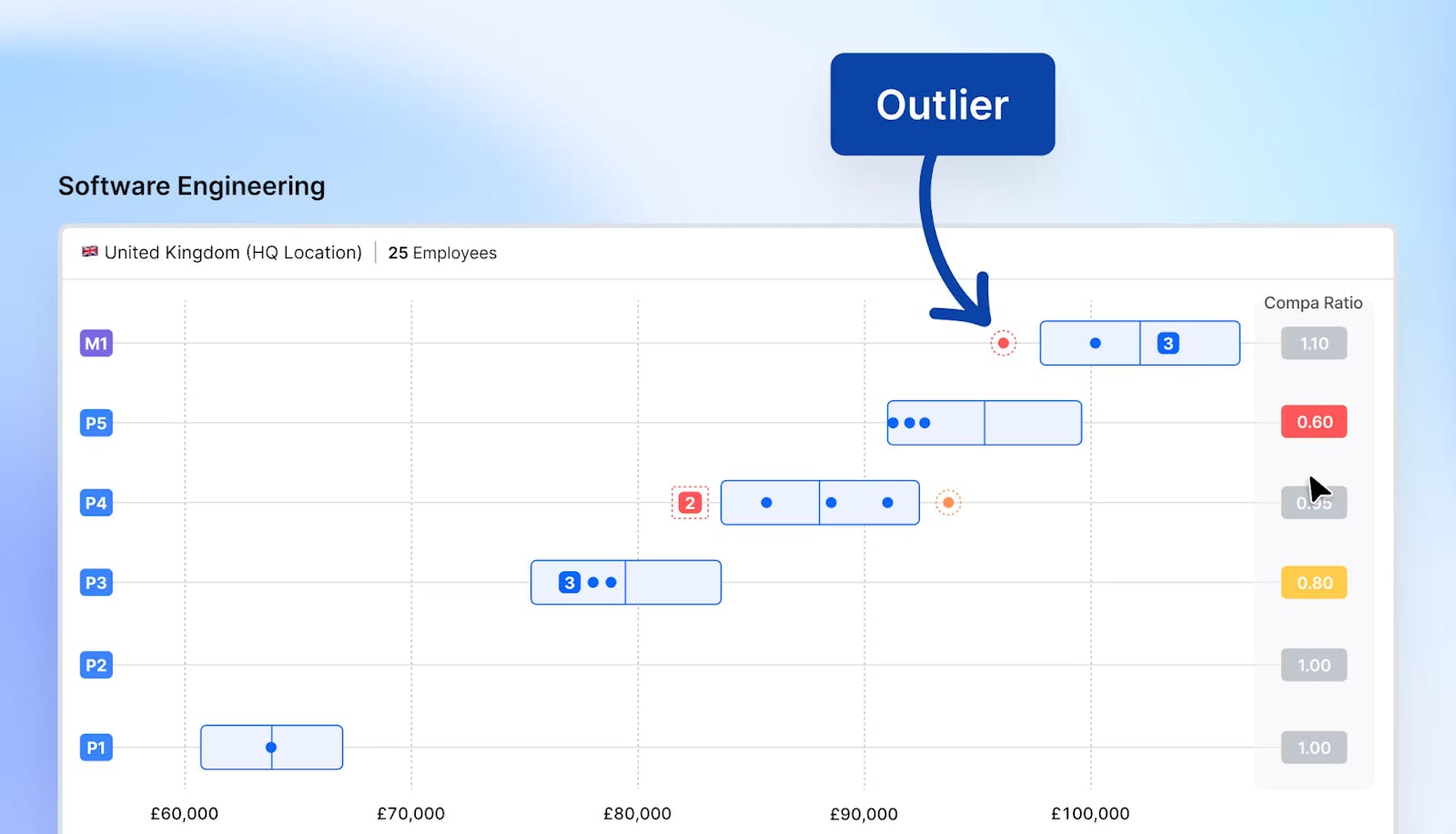
But, analysing the compa ratio requires salary bands to be in place. Plus, it won’t be insightful without first using up-to-date benchmarking data to refresh all salary bands – as they need to reflect any market changes that have occurred since the previous review.
So it keeps coming back to the need for strong compensation structures before introducing merit increases
These elements (employee performance and potential ratings, plus compa ratio analysis) are non-negotiables when determining merit increases – and, as we’ve seen, they require several Rewards structures to already be firmly in place.
Here’s a recap:
- A guiding total rewards philosophy which ensures that compensation adjustment decisions are always in-line with the company’s mission, values, and culture
- A robust, time-proven salary band structure that enables the compa ratio analysis
- Access to reliable, real-time benchmarking data (like Ravio’s) to understand how the market is shifting and which existing employees could be at risk of receiving a better offer elsewhere
- Well-defined performance expectations that are clearly communicated to managers and employees, and a robust culture of continuous feedback
- A job architecture, level framework, and career progression framework that sets expectations and informs next steps for employees who are consistently receiving high performance ratings.
If you’re confident that all of these elements are firmly in place, then you’re going to be able to run a sophisticated merit increase process – rewarding high-performing employees and reducing attrition risk, whilst still maintaining overall fairness in pay structures.
If not, then my recommendation would be to focus on implementing strong foundational compensation structures first as part of the overall strategy, and then start to gradually scale up the use of compensation as a lever to reward performance. This will enable and maximise the effectiveness of merit increases over time, whilst at the same time support fairness and a thriving company culture.
How do you implement those strong compensation foundations? Lessons learnt from the early days of Deliveroo
If you don’t already have those foundations in place yet, where should you begin?
I’ve worked with a number of startups over the years, and striking the right balance is still never easy when it comes to putting those compensation structures in place and scaling them up as a company grows and matures.
My time at Deliveroo is perhaps the best illustration of this, where we had to accelerate implementation because of the hyper growth environment the company found itself within.
Deliveroo was founded in 2013, and their first People hire was Vaso Parisinou (now Chief People Officer at Ravio) in March 2015.
Deliveroo scaled incredibly quickly, without any structure behind hiring and compensation practices
When Vaso joined the team there were 30 people in the entire organisation, and the company traded in just two London zones. Less than 9 months later, by the end of 2015, there were 600 people and the company was trading in over several countries – and that was still just the start of Deliveroo’s growth.
Each of those 12 countries had a team of a different size, with a General Manager who was responsible for hiring their own team. There was no centralised recruitment and no structures in terms of hiring practices, job title conventions, or compensation structures.
In fact, there were over 1,000 job titles in use. In many instances the same job title was used for employees with wildly different responsibilities – two Marketing Directors, but one responsible for a three-person marketing team in a small market like the Netherlands, and one responsible for a large, complex, multi-disciplined marketing team in the UK.
These are the kind of problems that can arise during growth at any company, but were hugely exacerbated by the incredibly rapid growth of Deliveroo.
As Vaso rightly puts it: “the speed and size of the scale in people was truly astonishing – it’s no wonder we couldn’t keep up!”
Getting compensation structures in place ahead of Deliveroo’s first compensation review
In 2018 Deliveroo was gearing up to run its first fully-fledged merit cycle, and by that point the company had scaled to over 2,500 employees, operating in over 100 cities in 12 countries worldwide.
I came on board to work with Vaso, the senior leadership in each of the 12 markets, and the C-suite to bring some much-needed structure ahead of the first pay review – which was only a few weeks away!
Our starting point was to understand what kind of compensation philosophy, job architecture, job levels, and job titles were right for Deliveroo.
We introduced a centralised Deliveroo job architecture, level framework and job titling convention which could be implemented globally ahead of the compensation review. These would be the foundational structures that we could then build on over time.
It was also important for us to implement a salary band structure quickly. The hyper growth context meant that competitive pay for certain roles and skills was increasing fast, in some cases changing quarterly. Employees were well aware of this, with media coverage about the fast growth in the tech sector, so their focus for the pay review was to make sure they would still be paid fairly and competitively if they were to stay with Deliveroo – meaning talent retention and attraction became a daily topic of conversation.
We needed a structure to help us stay on top of that, and so we also set up salary bands for the first compensation review, using benchmarking data to ensure market competitiveness and give us a structure that we could regularly refresh.

Compensation philosophy, job title conventions, job architecture, job levels, benchmarking, salary bands. It’s already a huge amount of work for one cycle – and one which we had very little time to prepare for due to the hyper growth environment!
On top of this we also introduced several other new processes during that first compensation review such as new equity compensation for all employees, changes to notice periods, eliminating many bonus structures, and more.
These are all vital structures to enable consistent compensation, equity, performance, and promotion decisions – but in hindsight, it was way too much to introduce all at once before a first ever compensation review.
The problem with introducing too much compensation structure, too fast
It was a huge challenge, and incredibly stressful for the People and Rewards Team, senior leaders, and C-suite to manage, communicate, and deliver an organisational change of this size and complexity in such a short period of time.
It was also an overwhelming amount of information for line managers to understand, digest and explain effectively, and for employees to take in – especially in a team where, up until then, there had been no structure at all for hiring, compensation and performance. We had to be especially careful with job titles, because employees had (understandably!) become psychologically attached to their job title and were reluctant to change it, so that transition needed to be managed over a period of time.
I'm proud to say those involved rose to the challenge and successfully delivered the first ever compensation review using these foundational structures. The experience came with invaluable learnings that have informed how both Vaso and I have each gone on to approach compensation and rewards strategies at the companies we’ve worked with since.
The key takeaway: start with a simple framework, and build from there
There are a few big changes I’d make to this scenario if I were to go back in time to 2015 Deliveroo:
- Be clearer on the compensation philosophy first. Spending more time on developing a set of overarching principles in alignment with Deliveroo’s leadership team would have given us a strong foundation for the structures we were putting in place,whilst also making it much easier to get stakeholder alignment on each piece over time.
- Get started earlier. A longer period of time to implement the road map of changes required for the hyper growth environment Deliveroo was in would have enabled and supported better change management and a softer landing of those changes with managers and employees.
- One piece at a time, and communicate every step of the way. Instead of launching several new structures and related processes on managers and employees all at once, we should have introduced each piece one at a time and ensured that full understanding of that piece was gained before moving on.
The key is to start small – as Vaso put it herself when we reminisced on our time at Deliveroo.
“Keep it simple, less is absolutely more for those first compensation reviews”.
Put in place a simple and agile framework that gives the structure you need to ensure fair and consistent decisions, and build on that framework as the company expands and more structure is naturally required.
It can vary depending on individual company needs and culture, as well as timing. But, for most companies, the right place to start is with simple versions of:
- Compensation philosophy
- Job architecture
- Levelling framework.
Ideally I would aim to have those elements in place well before you kick-off your first formal compensation review, and with enough time for them to be aligned on, digested, understood and onward communicated to leaders and employees.
Next comes choosing your benchmarking data provider and introducing a basic salary band structure. Other elements include performance management expectations, manager training, feedback processes – but the timing on when to introduce these will vary depending on compensation philosophy and company culture.
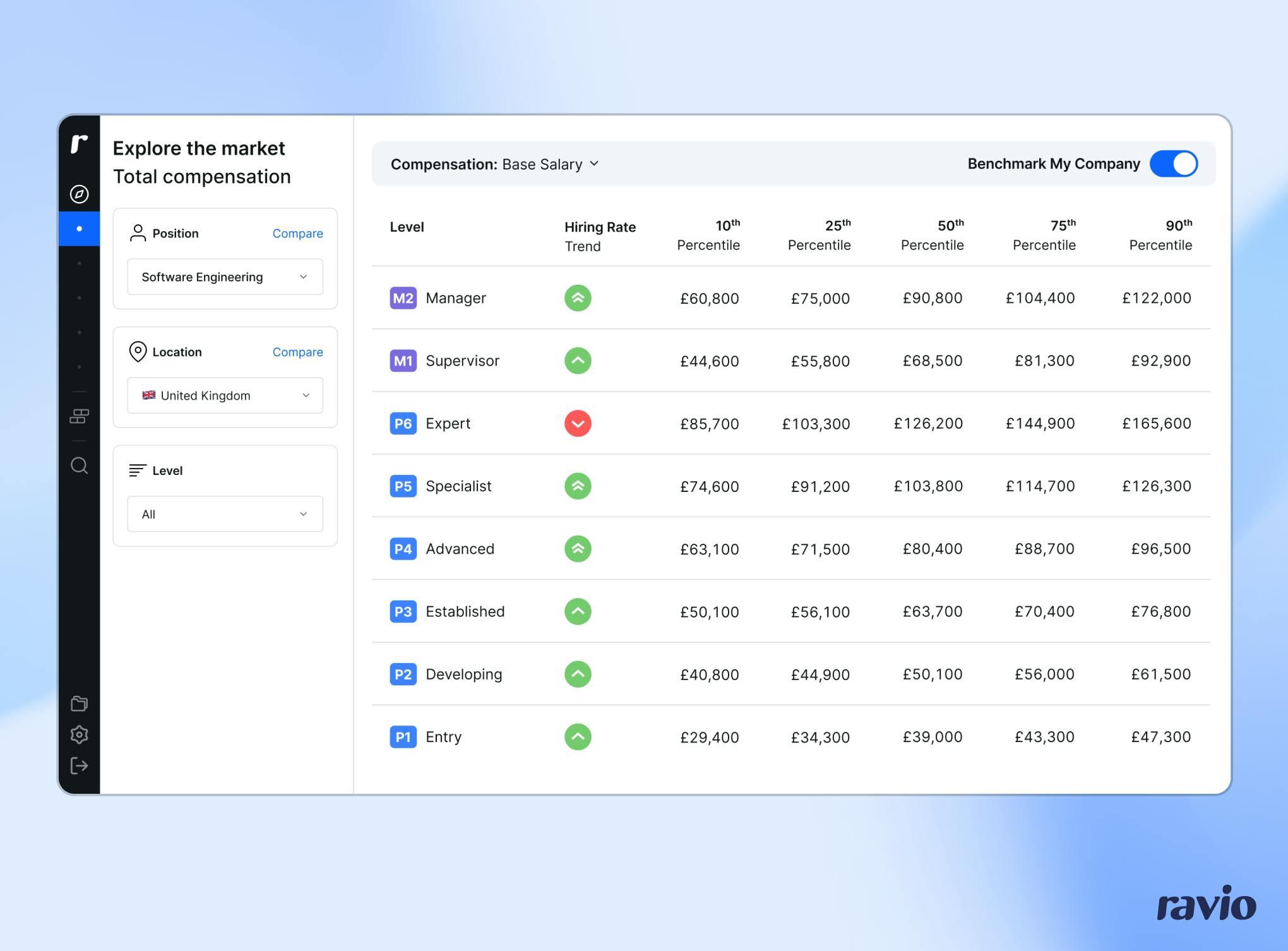
Build on and refine each element as you go and, as I’ve mentioned before, always spend plenty of time focused on leader and employee education of each element to ensure transparency and understanding.
It’s at this point that you’re probably ready to introduce merit increases, making pay decisions and adjustments based on performance and market competitiveness at the next compensation review – whilst still being able to manage the overall fairness of compensation, and maintain employee engagement and company culture.
Now it’s over to you!
If you have any questions on anything I’ve written in this blog post, please feel free to reach out to me via LinkedIn – I’m always more than happy to chat.

About Rob
Rob Green is the founder of his own consultancy firm, Darwin Consulting, as well as working as part of the MCR Consulting team, focused on Global Total Rewards, Employee Benefits and Wellbeing.
With over 20 years of Global Total Rewards expertise across diverse sectors and organisations of all sizes, Rob has extensive experience from the UK, US, Europe, Africa, Middle East and Asia regions. Rob partners with business owners, C-suite leaders, HR teams, and other key stakeholders to design Total Rewards strategies that elevate talent attraction and retention in competitive markets.
Specialties include designing compensation frameworks, pre-IPO and post-IPO equity plans, developing employee benefits and wellbeing programs, and structuring executive compensation.



